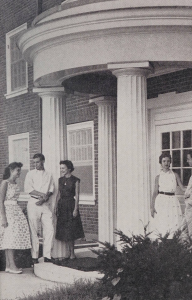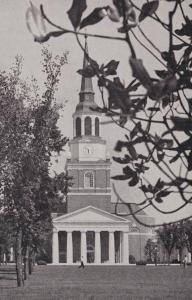Wake Forest University is a school that’s proud of its traditions—and nothing illustrates the history of those traditions like student handbooks from the past 100 years or so. Thanks to our partnership with WFU, we’ve just uploaded a batch of those handbooks from 1906 through 2010.
Beginning on the original campus in Wake Forest, N.C. (where the school was founded in 1834), these handbooks follow students and faculty through several of the school’s major milestones, including a move to Winston-Salem, N.C., in 1956.
This photo, from the 1956 handbook, is from the first year that students were at the Winston-Salem campus. Except for the fashion, this might look like a familiar scene to many current WFU students.
The handbook reads, “Among Wake Forest’s oldest and most cherished traditions are the magnolias. The tree’s beautiful white blossoms have for many become almost synonymous with the name Wake Forest. The former campus in the village of Wake Forest was covered with magnolias, and that tradition has been transplanted here with all the others. The trees are plentiful on the new campus and are placed in prominent positions.” In fact, there is still an area of campus know as the “mag quad” (short for “magnolia”) near the first-year dorms where the trees are supposedly grown from old campus saplings.
Throwing things way back to 1913, it’s easy to see the school’s early connections to the Baptist Church. The 1913-14 student handbook is presented by the College Young Men’s Christian Association (Y.M.C.A), and it’s clear that participation in church activities was a big part of life as a student. Bible study is encouraged for all students, and “Attendance upon Daily Prayers and upon Sunday morning service is required.” The 1913-14 handbook is also truly the size of a person’s hand—a trend that has been abandoned with regard to contemporary “handbooks.”
Another big change for Wake Forest came in 1942, when the school began admitting women. This was due to the decline in enrollment as young men went to fight in the Second World War. You wouldn’t know it based on the language in the 1942-43 handbook, which uses phrases like, “each new man will be assigned to an adviser” and “New men who enjoy singing with their fellow students and who can carry a tune are not only asked but urged to report for the first practice.” Though there is mention of social societies holding “smokers,” to which they invite “all the women, half the men, and a faculty member.”
Also in the 1942-43 handbook? An ad for Shorty’s—the original restaurant in Wake Forest, N.C.
In 1961, the school formally ended racial segregation, extending admission to students of color (however, there doesn’t seem to be any indication of this in the 1961 handbook or even the 1962 handbook). Instead, there’s a photo that depicts a tradition that, again, many Wake students of today will find familiar.
To see the full batch of Wake Forest University handbooks, click here. To learn more about Wake Forest University as it is today, you can visit their partner page or their website.



